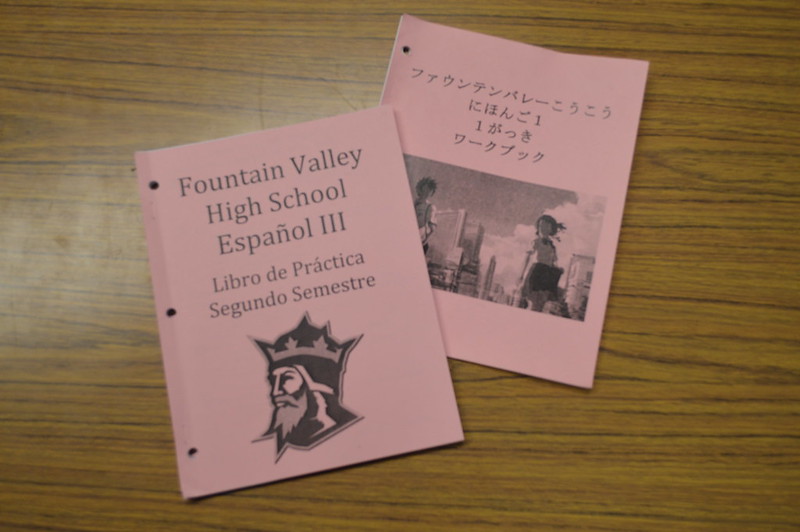
By Jennifer Trend
The FVHS World Language Department is expanding its use of teacher-curated class workbooks, part of a yearslong effort to make class resources more uniform, affordable and accessible for students.
World language classes have long used class workbooks produced by outside publishers for homework, lessons and in-class activities. In recent years, however, the World Language Department has transitioned to printing its own teacher-created, staple-bound paper workbooks.
Spanish classes have used paper workbooks rather than workbooks provided by a publisher for the past five years, and Japanese 1 and 2 classes began using paper workbooks at the start of the 2019-2020 school year. While French classes do not currently need or use teacher curated workbooks, teachers say they could provide them if the need arises.
To create the workbooks, teachers take inspiration from previously used publisher provided workbooks, their own lessons and current pop culture trends. Having full control of the content allows teachers to easily teach what they want students to practice, annually revise their workbooks to keep them up to date, and ensure uniformity within each level, even if teaching styles are different.
“[The workbooks have] allowed us to have everything all in one place for students, rather than having a handout here, having a handout there and having all these different papers for students to keep track of,” World Language Department Head Jim Diecidue said. “Everything is contained in that workbook and all in one place.”
In addition to making class content more customizable, consolidated and flexible, the department’s workbooks also make it more cost-effective. Affordability was a key concern for Japanese classes, where students used to have to purchase workbooks from the publisher at a cost of around $40.
“Spanish and French classes received workbooks for free,” said Tanaka. “So it was only the Japanese students who would pay the $40, while the Spanish and French students wouldn’t pay anything. It wasn’t fair for students.”
To address the cost issue, Tanaka created the current Japanese workbooks with the help of past FVHS Japanese teacher Sachi Katashima and the Japanese teachers at Marina High School. The workbooks were introduced to Japanese 1 and 2 this school year, and will be implemented for Japanese 3 and 4/AP next year, after Tanaka’s leftover stock of Japanese 3 and 4/AP workbooks runs out.
While all Spanish classes except Spanish 4 and Español 2 use teacher curated workbooks, and all four levels of Japanese will use workbooks in the 2020-2021 school year, the situation is different for French classes at FVHS. French classes are currently two to three years into a six-year contract with publishers to receive workbooks for free. When the contract expires, students will have to purchase a workbook from the publisher for $15 to $20.
The department’s paper workbooks for Spanish and Japanese classes currently cost $8. Students who are unable to pay have the options of printing pages of the workbook at home or borrowing a copy that will be returned at the end of the semester.
“Every student does get a workbook, and we make that work for the students who cannot purchase one,” Diecidue said. “We don’t want anyone in a situation where they’re disadvantaged or don’t have the same resources as everyone else, so it works out that the student’s who can’t pay for one are able to have the resources that they need.”
The affordability offered by the paper workbooks has been a key benefit for Spanish classes, and has Tanaka excited now that it is expanding to include Japanese classes.
“Basically, to be able to lower the price to the same as the Spanish class is very amazing. To have to tell students to pay $40 for the workbooks hurt my heart,” said Tanaka. “Eight dollars is the same as one Starbucks coffee, so it’s the same as giving up one coffee for each semester, so I think that it’s very good.”





